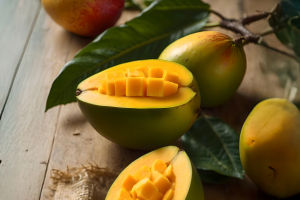There's a good chance you've seen papaya in your local market, bought it for a fruit salad, or maybe sipped on papaya juice while on vacation.
But beyond its tropical flavor, do we actually understand what this fruit does for our bodies—especially when it's fully ripe?
Let's slow down and really talk about it. Ripe papaya isn't just a refreshing snack. It's packed with specific enzymes and nutrients that quietly support digestion, skin repair, and even how we recover after eating heavy meals. Let's unpack why this humble fruit deserves a permanent spot in your kitchen.
1. Papain: The Enzyme That Does the Heavy Lifting
At the heart of ripe papaya's health power is papain, a natural enzyme that helps your body break down proteins. While unripe papaya also contains this enzyme, the ripe version offers a gentler, easier-to-digest source—especially useful if you've had a big, greasy meal or tend to feel bloated after eating.
According to Dr. Eleanor Vance, a specialist in nutritional enzymology and gastrointestinal physiology:
"Ripe papaya delivers papain—a proteolytic enzyme essential for protein hydrolysis—in a bioavailable yet physiologically gentler form than unripe fruit. While papain concentration is higher in unripe papaya, the ripe fruit's matrix enhances enzymatic accessibility and reduces gastric irritation, making it particularly valuable for mitigating postprandial discomfort after high-fat meals or in individuals with functional dyspepsia."
Here's what papain helps with:
1. Digestion – It helps your body break down protein into smaller, more usable forms.
2. Post-meal bloating – Papain can reduce the heavy, sluggish feeling.
3. Nutrient absorption – By easing digestion, your body can pull more nutrients from food.
Some people even take papaya enzyme supplements after meals—but the real fruit is a much more natural and flavorful option.
2. Natural Fiber That Eases Your Gut
Ripe papaya is rich in soluble fiber, which acts like a gentle sweeper for your digestive tract. If you struggle with constipation or irregular bowel movements, including half a ripe papaya in your breakfast routine could make a noticeable difference within days.
Why the fiber in papaya stands out:
1. It's soft and non-irritating—ideal for sensitive stomachs.
2. It feeds the good bacteria in your gut.
3. It helps regulate your system without harsh laxatives.
And if you're someone who skips breakfast? Just a few papaya cubes with a slice of toast is enough to get things moving.
3. Your Skin Might Thank You
You've probably heard people say, "You are what you eat." When it comes to papaya, that might literally show on your skin. Ripe papaya is rich in vitamin C and beta-carotene, two antioxidants that play important roles in skin repair and brightening.
Some people even use mashed ripe papaya as a face mask. But even before you go there, just eating it regularly could help:
1. Boost your natural collagen production
2. Reduce oxidative stress from sun and pollution
3. Support skin cell turnover, helping dull skin look fresher
This doesn't mean it's a magic fix, but when combined with water and a balanced diet, papaya definitely plays its part.
4. Helps After "Heavy" Eating Days
We all have those days—weddings, family dinners, or just a fast-food craving. Papaya can act like a reset button for your digestive system the next morning. The enzymes and fiber help move things along, while the fruit's high water content keeps you hydrated and flushed.
Instead of reaching for antacids or digestion teas, try this easy blend:
• 1 cup ripe papaya
• Half a banana
• Splash of oat or almond milk
• Ice
Blend and sip slowly. It's not just refreshing—it's doing real cleanup inside your gut.
5. Not Just a Summer Fruit
Many people think papaya is only good when it's hot out. But actually, it's a smart fruit to include year-round—especially during the holiday season when digestion can get tricky. Plus, ripe papayas are often imported from tropical countries, so they're available even in winter months at major grocery chains.
So, How Do You Know It's Ripe?
A ripe papaya has:
• Yellow to orange skin (some green patches are okay)
• A soft but not mushy feel when pressed
• A slightly sweet scent from the stem end
If it's still too green, leave it on the counter for a couple of days. It ripens fast!
Have you been underestimating papaya this whole time? Most of us have. It's not just something to add color to a fruit bowl—it's a true helper when your gut, skin, or even mood needs a little support. Next time you're at the store, grab one, let it ripen, and give your body a gentle nudge toward better digestion and glow.
Have you tried eating ripe papaya daily or using it in a smoothie? Did it help your stomach or your skin? I'd love to hear your experience. Let's swap papaya stories!


